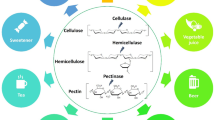Abstract
Lipase (triacylglycerol ester hydrolase, EC 3.1.1.3) fromRhizopus arrhizus was immobilized in this work by adsorption on microporous polypropylene and employed for the lipolysis of palm kernel olein. The optimum operating temperature for the lipolysis reaction was determined. The reaction follows Michaelis-Menten kinetics with product competitive inhibition for substrate concentrations in the range of 0.175–0.877M. The apparentK m and Vmax were 0.42M and 691 U/mg protein, respectively. A dissociation constant of the enzymeproduct complex,K I = 29.73 mM, for the product inhibition was also determined. Additionally, the time-courses of the reaction for various substrate concentrations were obtained and correlated sufficiently with those predicted from the theoretical rate equation for a period of up to 2 h. Experimental results indicated that discrepancies between the observed results and the predicted ones increase with reaction time.
Similar content being viewed by others
Abbreviations
- ES*:
-
complex of enzyme and substrate molecules
- Et :
-
total mass of enzyme in the reactor (mg)
- k cat :
-
rate constantin the Michaelis-Menten equation (mmo1/min mg protein)
- K I :
-
dissociation constant for the complex EP* (M)
- K m :
-
apparent Michaelis constant (M)
- P:
-
oleic acid concentration (M)
- P0 :
-
initial concentrationof oleic acid (mM)
- S:
-
substrate concentration based on ester bond (M)
- S0 :
-
initial value of S (M)
- t:
-
reaction time (min)
- VI :
-
initial velocityof reaction (μmol/min)
- Vmax :
-
apparent maximal velocity (μmol/min)
- X:
-
conversion of substrate.
References
John, V. T. and George, A. (1991), inBiocatalysts for Industry, Dordick, J. S., ed., Plenum, New York, pp. 193–217.
Brink, L. E. S., Tramper, J., Luyben, K. Ch. A. M., and Van’t Riet, K. (1988),Enzyme Microb. Technol. 10, 736–743.
Dordick, J. S. (1991), inApplied Biocatalysis, Blanch, H. W. and Clark, D. S., eds., Marcel Dekker, New York, pp. 1–51.
Bar, R. (1987), inBiocatalysis in Organic Media, Laane, C., Tramper, J., and Lilly, M. D., eds., Elsevier Science, Amsterdam, pp. 147–153.
Lilly, M. D. and Woodley, J. M. (1985), inBiocatalysts in Organic Syntheses, Tramper, J., van der plas, H. C., and Linko, P., eds., Elsevier, Amsterdam, pp. 179–192.
Hailing, P. J. (1994),Enzyme Microb. Technol. 16, 178–206.
Mojovic, L., Siler-Marinkovic, S.,. Kukic, G., and Vunjak-Novakovic, G. (1993),Enzyme Microb. Technol. 15, 438–443.
Valivety, R. H., Hailing, P. J., and Macrae, A. R. (1992),Biochim. Biophy. Acta 1118, 218–222.
Cassells, J. M. and Hailing, P. J. (1988),Enzyme Microb. Technol. 10, 486–491.
Brady, C., Metcalfe, L., Slaboszewski, D., and Frank, D. (1988),J. Am. Oil Chem. Soc. 65, 917–921.
Otero, C., Pastor, E., Fernandez, V. M., and Ballestero, A. (1990),Appl. Biochem. Biotechnol. 23, 237–247.
Ruckenstein, E. and Wang, X. (1993),Biotechnol. Tech. 7, 117–122.
Reslow, M., Adlercreutz, P., and Mattiasson, B.. (1988),Eur. J. Biochem. 172, 573–578.
Malcata, F. X., Reyes, H. R., Garcia, H. S., Hill, C. G., Jr., and Amundson, C.H., (1990),J. Am. Oil Chem. Soc. 67, 890–910.
Lowry, R. R. and Tinsley, I. J. (1976)J. Am. Oil Chem. Soc. 53, 470–472.
Han, D. and Rhee, J. S. (1986),Biotechnol. Bioeng. 28, 1250–1255.
Celebi, S. S., Ucar, T., and Caglar, M. A. (1981), inAdvances in Biotechnology, vol. I, Moo-young, M., Robinson, C. W., and Veniza, C., eds., Pergamon, Toronto, pp. 691–697.
Gatt, S. and Bartfai, T. (1977),Biochim. Biophy. Acta 488, 13–24.
Rietsch, J., Pattus, F., Desnuelle, P., and Verger, R. (1977)J. Biol. Chem. 252, 4313–4318.
Brockerhoff, H. (1971),J. Biol. Chem. 246, 5828–5831.
Padmini, P., Rakshit, S. K., and Baradarajan, A. (1994),Enzyme Microb. Technol. 16, 432–435.
Ghatorae, A. S., Bell, G., and Hailing, P. J. (1994),Biotechnol. Bioeng. 43, 331–336.
Author information
Authors and Affiliations
Rights and permissions
About this article
Cite this article
Ju, YH., Huang, FC. Lipase immobilized on hydrophobic microporous polypropylene for the hydrolysis of palm kernel olein. Appl Biochem Biotechnol 55, 17–26 (1995). https://doi.org/10.1007/BF02788745
Received:
Accepted:
Issue Date:
DOI: https://doi.org/10.1007/BF02788745




